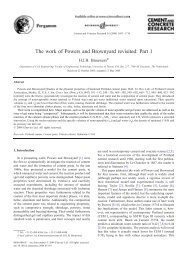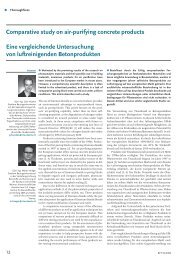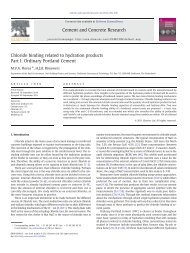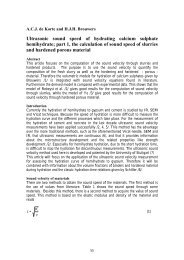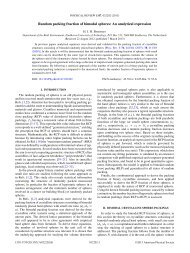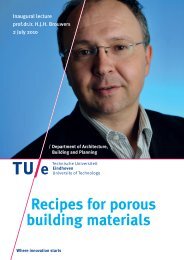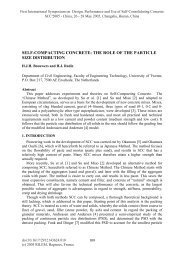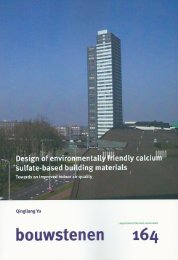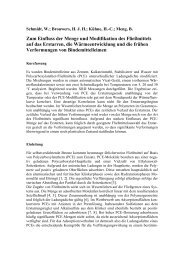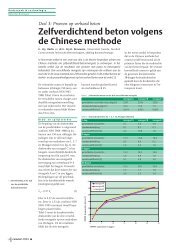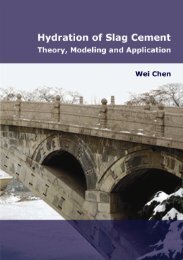RCM: A new model accounting for the non-linear ... - Jos Brouwers
RCM: A new model accounting for the non-linear ... - Jos Brouwers
RCM: A new model accounting for the non-linear ... - Jos Brouwers
You also want an ePaper? Increase the reach of your titles
YUMPU automatically turns print PDFs into web optimized ePapers that Google loves.
300 P. Spiesz et al. / Construction and Building Materials 27 (2012) 293–304<br />
(4) and (22)), which <strong>the</strong>re<strong>for</strong>e is only related to <strong>the</strong> pore structure<br />
of concrete. Fur<strong>the</strong>rmore, <strong>the</strong> porosity of concrete is applied in <strong>the</strong><br />
equations in order to split <strong>the</strong> total mass balance to liquid and solid.<br />
Thus, in view of coherency, this diffusion coefficient also takes<br />
<strong>the</strong> porosity into account. There<strong>for</strong>e, <strong>the</strong> chloride diffusion coefficient<br />
adopted in <strong>the</strong> <strong>new</strong> chloride transport <strong>model</strong> is <strong>the</strong> effective<br />
diffusivity, as described in Eq. (21).<br />
5.3. Numerical solution<br />
In order to obtain <strong>the</strong> numerical solution of Eqs. (17) and (18) a<br />
<strong>for</strong>ward discretization is per<strong>for</strong>med (according to <strong>the</strong> scheme presented<br />
in Fig. 6) and reads as follows:<br />
u cðiþ1;jÞ cði;jÞ<br />
þ u<br />
Dt<br />
cðiþ1;jþ1Þ cðiþ1;jÞ<br />
Dx<br />
" #<br />
1=n<br />
Cbðiþ1;jÞ<br />
¼ k cðiþ1;jÞ<br />
; ð24Þ<br />
ð1 uÞq s<br />
Kb<br />
Cbðiþ1;jÞ Cbði;jÞ<br />
Dt<br />
" #<br />
1=n<br />
Cbði;jÞ<br />
¼ k cði;jÞ<br />
; ð25Þ<br />
where Dt is <strong>the</strong> interval of time, i is <strong>the</strong> position in time, (i =1...t/<br />
Dt), Dx is <strong>the</strong> interval of distance, j is <strong>the</strong> position in concrete<br />
(j =1...L/Dx).<br />
Solving Eqs. (24) and (25) <strong>for</strong> c (i+1,j+1) and C b(i+1,j) respectively,<br />
gives as follows:<br />
cðiþ1;jþ1Þ ¼ cðiþ1;jÞ<br />
Dx<br />
Cbðiþ1;jÞ ¼ Cbði;jÞ þ<br />
u u cðiþ1;jÞ cði;jÞ<br />
Dt<br />
Dt<br />
k cði;jÞ<br />
qsð1 uÞ<br />
with <strong>the</strong> boundary conditions:<br />
cði;j¼1Þ ¼ c0;<br />
Kb<br />
þ k cðiþ1;jÞ<br />
Cbði;jÞ<br />
Kb<br />
Cbðiþ1;jÞ<br />
Kb<br />
! !<br />
1=n<br />
;<br />
ð26Þ<br />
!<br />
1=n<br />
; ð27Þ<br />
Cbði¼1;jÞ ¼ Cbi: ð28Þ<br />
Fig. 6. Discretization scheme.<br />
5.4. Simplified analytical solution<br />
The system of Eqs. (17) and (18) can be solved analytically <strong>for</strong><br />
zero initial chloride content in concrete (Cbi = 0) and n = 1, i.e. <strong>linear</strong><br />
binding iso<strong>the</strong>rm and <strong>non</strong>-equilibrium conditions. In order to solve<br />
this system a trans<strong>for</strong>mation of variables is adopted as follows:<br />
C ¼ t ux<br />
; ð29Þ<br />
u<br />
v ¼ x; ð30Þ<br />
where v is <strong>the</strong> trans<strong>for</strong>med distance and C is <strong>the</strong> trans<strong>for</strong>med time.<br />
C = 0 corresponds to <strong>the</strong> time needed <strong>for</strong> <strong>the</strong> chloride penetration<br />
front to attain a given position x in <strong>the</strong> concrete.<br />
Trans<strong>for</strong>ming <strong>the</strong> derivatives of t and x and applying Eqs. (29)<br />
and (30) gives as follows:<br />
@ @<br />
¼ ; ð31Þ<br />
@t @C<br />
@ u @ @<br />
¼ þ : ð32Þ<br />
@x u @C @v<br />
Inserting Eqs. (31) and (32) into Eqs. (17) and (18) gives <strong>for</strong> liquid<br />
and solid respectively:<br />
u @c<br />
¼ k c<br />
@v<br />
Cb<br />
Kb<br />
@Cb<br />
ð1 uÞqs ¼ k c<br />
@C<br />
; 0 < v < w; ð33Þ<br />
Cb<br />
Kb<br />
; 0 < C < wu<br />
; ð34Þ<br />
u<br />
where <strong>the</strong> chloride penetration front w = ut/u and <strong>the</strong> pertaining<br />
boundary conditions (invoking Cbi = 0) read as follows:<br />
cðv ¼ 0; CÞ ¼c0<br />
Cbðv; C ¼ 0Þ ¼0:<br />
Introducing <strong>the</strong> following dimensionless variables:<br />
ð35Þ<br />
X ¼ c<br />
; where c0 is <strong>the</strong> maximum free-chloride concentration;<br />
c0<br />
0 6 X 6 1 ð36Þ<br />
Y ¼ Cb<br />
;<br />
Kbc0<br />
where Kbc0 represents <strong>the</strong> maximum bound-chloride<br />
concentration; 0 6 Y 6 1 ð37Þ<br />
n ¼ vk<br />
; ð38Þ<br />
u<br />
s ¼<br />
Ck<br />
Kbð1 uÞq s<br />
; ð39Þ<br />
into Eqs. (33) and (34) gives as follows:<br />
@X<br />
¼ ðX YÞ; ð40Þ<br />
@n<br />
@Y<br />
¼ðX YÞ; ð41Þ<br />
@s<br />
with <strong>the</strong> following boundary conditions:<br />
Xðn ¼ 0; sÞ ¼1<br />
Yðn; s ¼ 0Þ ¼0:<br />
ð42Þ<br />
The analytical solution of Eqs. (40) and (41) applying <strong>the</strong><br />
boundary conditions (Eq. (42)) reads as follows [11]:



